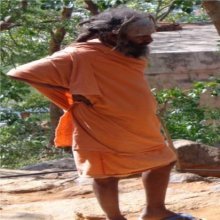Ochre garment: 1 definition
Introduction:
Ochre garment means something in Hinduism, Sanskrit. If you want to know the exact meaning, history, etymology or English translation of this term then check out the descriptions on this page. Add your comment or reference to a book if you want to contribute to this summary article.
Images (photo gallery)
In Hinduism
Yoga (school of philosophy)
Source: ORA: Amanaska (king of all yogas): A Critical Edition and Annotated Translation by Jason BirchOchre Garments are denoted by the Sanskrit term Dharaṇa, according to the Amanaska Yoga treatise dealing with meditation, absorption, yogic powers and liberation.—Accordingly, as Īśvara says to Vāmadeva: “[...] Putting on ochre garments (kāṣāya-grahaṇa), carrying a skull, plucking out clumps of hair, maintaining non-vedic religious observances, ashes, ascetic clothing and matted locks, behaving as if mad, [the ascetic practice of] nakedness, [studying] the Vedas, Tantras and so on and the meeting [of learned people] for [reciting] poetry in the assembly: All [this] is exertion for the sake of filling one's stomach and is not the cause of the highest good. [...]”.

Yoga is originally considered a branch of Hindu philosophy (astika), but both ancient and modern Yoga combine the physical, mental and spiritual. Yoga teaches various physical techniques also known as āsanas (postures), used for various purposes (eg., meditation, contemplation, relaxation).
See also (Relevant definitions)
Partial matches: Robe, Cloth, Garment.
Query error!
Full-text (+66): Kashaya, Tattudu, Pitavasana, Pita, Raktacivara, Raktacivaradharana, Grahana, Kashayagrahana, Kashayavastra, Vasana, Aramavasa, Annapana, Ekadanda, Unmatta, Abhojya, Darshita, Unmattatva, Religion, Civaradharana, Lingagrahana.
Relevant text
Search found 19 books and stories containing Ochre garment, Ochre cloth, Ochre clothes, Ochre robe, Ochre robes; (plurals include: Ochre garments, Ochre cloths, Ochre clotheses, Ochre robes, Ochre robeses). You can also click to the full overview containing English textual excerpts. Below are direct links for the most relevant articles:
A Prayer Answered < [July – September, 1982]
Sita: Power, Penance, Promise - An Introduction < [October – December, 1988]
Symbolism in the Three Plays of Tagore 'Muktadhara', 'Natirpuja' and 'Chandalika' < [January – March, 1985]
The Bhikkhus Rules (by Bhikkhu Ariyesako)
Becoming A Novice < [Part Two]
Chapter 2 - Relationships < [Part Three]
Becoming A Bhikkhu < [Part Two]
Agni Purana (by N. Gangadharan)
Chapter 229 - The significance of Dreams (svapna-adhyāya)
Chapter 364 - Words denoting men and the four classes of men
The body in early Hatha Yoga (by Ruth Westoby)
Sectarian Affiliation And Doctrinal Change < [Conclusion: Bodily sovereignty]
Maha Prajnaparamita Sastra (by Gelongma Karma Migme Chödrön)
Part 1 - For what reasons did the Buddha preach Mahāprajñāpāramitāsūtra? < [Chapter I - Explanation of Arguments]
Act 5.6: Those reborn turn to the Buddha to pay homage to him < [Chapter XIV - Emission of rays]
Bhūmi 5: the ground difficult to conquer (sudurjayā) < [Chapter XX - (2nd series): Setting out on the Mahāyāna]
